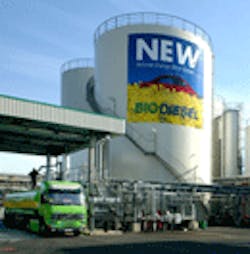A new report by global consulting firm Hart Energy finds that only government regulations mandating the use of biofuels such as ethanol and biodiesel are going to spur demand in the near future, as both fuels remain far costlier than their petroleum-derived opponents.
That eventually means not enough supply may be available by the end of the decade to meet the amount of biofuel required to meet government mandates – especially in biodiesel’s case.
“U.S. truckers can be pretty well assured that there won’t be any near-term spike in biodiesel being blended into the diesel stocks above 5%,” Paul Niznik, Hart’s biofuels manager, told Fleet Owner.
He explained that the primary feedstocks used to make biodiesel – especially soybeans – remain “unbelievably more expensive” than the oil from which diesel is produced, making biodiesel about 40% more expensive than petroleum-based diesel.
“The current $1/gal. tax credit for biodiesel only shaves off some of that extra cost, so the rest has to be borne by the buyer,” Niznik said.
“The era of ‘cheap feedstock’ when it comes to making biodiesel is well over, even in terms of ‘ugly feedstock’ sources such as animal fat,” he added. “That’s dried up much of the voluntary use of biodiesel. Only federal mandates such as the EPA’s [Environmental Protection Agency’s] renewable fuel standard [RFS] continues to spur biodiesel demand.”
The latest edition of Hart Energy’s annual Global Biofuels Outlook 2011-2020, just released this week, predicts a more difficult trend line for ethanol, as mandates that require ethanol blending with gasoline clash with the world’s ability to produce ethanol feedstock in significant quantity.
“Not enough other countries are in a position to export advanced bio-ethanol supplies to meet the requirements for the U.S., Europe and other countries," noted Tammy Klein, Hart’s assistant vp and the leader of its global study, said in the report.
For example, of the approximate 20 billion gals. of cellulosic ethanol that will be looked to by China and developed countries in the 2020 timeframe, Hart’s analysis projects that less than 10 to 12% of the total supply requirements will be commercially available in that timeframe.
Hart’s research also concludes that the U.S. Congress will ultimately have to modify RFS requirements by 2022 and modestly increase the longer-term requirements for corn-based ethanol under the program to compensate for the shortfall in commercial cellulosic biofuels volumes.
The study also found that ethanol will represent 12% of the gasoline pool and biodiesel and renewable diesel will represent 4% of the on-road diesel pool by 2020 for the countries included in the study.
“Of course, that assumes that public policy continues to be implemented largely as governments plan,” Klein said. “Full policy implementation will be a real challenge in a high feedstock price environment. Moreover, governments are increasingly challenged to fund incentives for biofuels. Higher feedstock prices and less government incentives have cooled capital lending in the finance sector as a result.”
Hart’s analysis concludes that global biodiesel supply will have to double over the 2010-20 timeframe to accommodate demand requirements that governments around the world are aiming to implement through fuel mandates.
“[But] we expect fewer new facilities will be built, with utilization at existing facilities increasing by 2020,” Klein noted. “For now, we continue to expect slack utilization rates for many plants around the world, continued industry consolidation and for facilities to shut down and never start back up.”
“There’s really no economic factor in the foreseeable future that will encourage biofuel production beyond the minimum needed to meet mandates,” Niznik added. “The only things that might change this would be an increase in tax credits to $2 or $3/gal. – not likely in this political climate – or a technological change that lowers the cost of producing biofuel. But any such technological change is at least 10 years off in the future.”
About the Author
Sean Kilcarr
Editor in Chief
Sean Kilcarr is a former longtime FleetOwner senior editor who wrote for the publication from 2000 to 2018. He served as editor-in-chief from 2017 to 2018.
